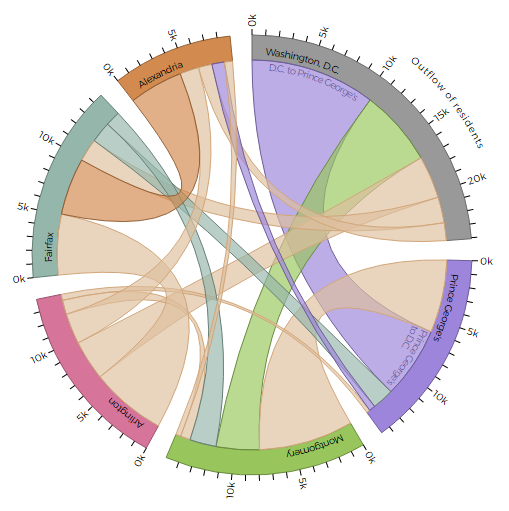While D.C. is an international city, with residents arriving from and departing to places all over the world, most of its domestic migration is very local: Prince George’s County, Montgomery County, Arlington County, Fairfax County, and Alexandria are the top five places within the U.S. that D.C. residents move to and from. They make up 31 percent of where new D.C. residents come from, and 42 percent of where D.C. residents go when they move out.
Within our interconnected metro region, what do these flows of people look like and what places are gaining or losing residents on net? The chart below shows the D.C. metro region by outflows of people moving from one location to another county or city in the region.
How to read the chart
Each arc on the outer edge of the circle represents the county where people moved from. The length of each arc represents the number of people who left that county to move elsewhere in the metro area (the connected arc).
Arcs are connected by ribbons. A ribbon’s thickness on each arc shows how many people left that place for the one at the other end of the ribbon. This lets us see how people flow in both directions: For instance, while roughly 10,000 people moved from D.C. (in gray) to Prince George’s County (in purple), only 5,000 moved in the other direction. That ribbon is purple because Prince George’s saw a net gain of residents from D.C.; each ribbon takes on the color of the “winner” of the net migration between the two places. Where ribbons are beige, the data is too close to report the net flow direction. Hover over any ribbon to see the migration flow numbers.
Within the metro region, more residents leave D.C. for neighboring counties than move there
Within the region, D.C. saw the most residents leave for a nearby municipality in the five-year period from 2010-2014—nearly 25,000. This is particularly striking since Fairfax, Montgomery and Prince George’s Counties all have hundreds of thousands more residents than D.C. District residents tend to be younger and more mobile however, so the large outpouring of D.C. residents to the rest of the metro area may be most reflective of the demographics of city dwellers. Meanwhile, Prince George’s, Montgomery, Arlington, and Fairfax County each had roughly 14,000 residents leave for a neighboring jurisdiction, and over 8,000 people moved out of Alexandria.
On net, the flow of people between the Virginia counties and D.C. is relatively even. However, neighboring Maryland counties gain the most D.C. residents both overall and on net. Prince George’s in particular is a popular destination for D.C. residents moving out; it receives nearly half of D.C. residents who leave the city but stay in the region.
As the D.C. Policy Center’s Executive Director Yesim Taylor recently showed, the top reason people move to D.C. from other parts of the metro area are for an easier commute (23 percent), while the top reason people leave D.C. for Maryland or Virginia is for cheaper or better housing (also 23 percent).[1] While some people actually move into D.C. from the broader metro area for housing-related reasons (13 percent), affordable housing is clearly an important factor for why many people leave D.C. for neighboring areas. The popularity of Prince George’s as a destination, and its relatively low real estate prices, adds to the evidence that housing is pricing people out of the District.
About the data
The primary data in this post, including the interactive infographic, are based on five-year estimates from the Census Bureau’s American Community Survey from 2010-2014 for counties in the D.C. metropolitan area. You can find complete code for this post on my GitHub page.
This post will also be available on DataLensDC.
